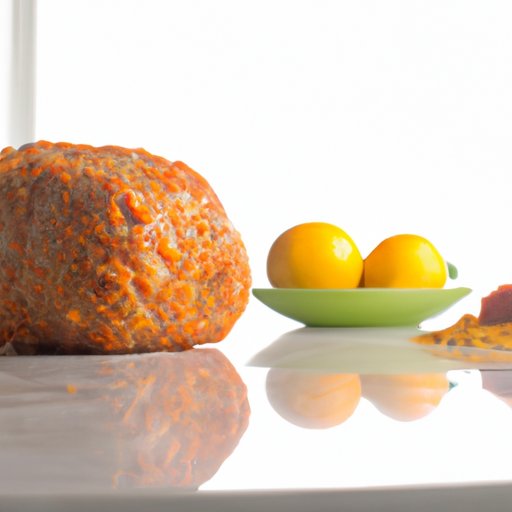
How to Make Glaze for Ham: Everything You Need to Know
Ham is a classic mainstay for holidays and special occasions, and to make it even more delicious, a sweet and savory glaze can take it to the next level. Glazing ham is all about adding flavor and texture to the meat, resulting in a roasted ham with a beautiful shiny finish. In this article, we dive into the basics of creating a glaze, explore regional variations, matching glaze with ham cuts, tips for easy application, and unique ingredients to incorporate into your ham glaze.
The Basics of Ham Glaze
The basic recipe for ham glaze is relatively straightforward, and it provides a sweet and caramelized finish to the roasted meat. You will need brown sugar, mustard, honey, and a little bit of vinegar. Blend all the ingredients together to make a paste, and then apply it to the ham about 30 minutes before it finishes cooking.
It is essential to use sugar in the glaze as it is responsible for creating the shiny finish on the ham. Sugar caramelizes and forms a crispy layer on top of the meat as it roasts. If you want to try different types of sugar, you can use maple syrup, molasses, or even fruit spreads, such as apricot or plum. Additionally, you can add seasonings like cloves, allspice, or cinnamon to the basic recipe to create a unique flavor profile.
Regional Variations
Ham glazes vary by region, and each one has its own distinct flavor profile. Here are a few traditional ham glazes from around the world:
Honey Glazed Ham (Southern USA)
The classic honey ham glaze is a Southern US favorite. It is easy to make with honey, Dijon mustard, and brown sugar. The Dijon mustard provides an excellent contrast to the sweetness of honey, creating a flavor balance that is perfect for any holiday meal.
Maple Glazed Ham (Canada)
In Canada, maple glazed ham is the go-to recipe. The glaze features ingredients like maple syrup, Dijon mustard, apple cider vinegar, and brown sugar. The maple syrup brings a rich sweetness to the ham, while the Dijon mustard provides a tang that balances everything out.
Cider Vinegar Glazed Ham (UK)
In the UK, the classic ham glaze features cider vinegar and a variety of spices. The vinegar and spices provide the perfect contrast to the salty ham. The spices used may include ground cinnamon, nutmeg, and cloves, which add a complexity of flavors that makes this glaze unique.
Matching Glaze with Ham Cut
The type of ham cut influences the flavor profile of the ham, and a glaze can enhance that flavor accordingly. Here are some tips for matching glaze with different types of ham cuts:
Shank Ham
Shank ham is a cut that comes from the rump end of the pig. It is a leaner cut of meat, and therefore it pairs well with sweet and sticky glazes. A mustard-based glaze will provide a good balance to the saltiness of the meat and create a fantastic flavor contrast.
Butt Ham
Butt ham comes from the upper part of the pig’s shoulder and has more fat content, resulting in a richer flavor. An apple or cherry glaze is an excellent pairing for a butt ham because the fruitiness balances the richness of the meat.
Tips for an Easy Application
To get a perfect finish, it is essential to apply glaze evenly and in layers. Here are some tips for an easy application:
Use a Bristled Brush
A bristled brush is the best option to use when applying glaze. The bristles help to apply an even layer of glaze to the meat’s surface, ensuring that the glaze covers the whole ham.
Baste Often
You will want to baste your ham regularly to achieve that stunning, shiny finish. Ideally, you should baste every 10-15 minutes, depending on the size of the ham.
Cook to Perfection
Cooking the ham to perfection is necessary to achieve an ideal balance between the juiciness of the meat and the sweetness of the glaze. Don’t overcook the ham as it will dry out, and the glaze will become too dark.
Non-traditional Glaze Ingredients
If you want to venture into more unusual and modern flavors to complement the ham, there are plenty of ingredients to choose from:
Fruit Chutneys
Fruit chutneys provide a sweet and savory taste that is perfect for enhancing ham’s flavor. Mango chutney works particularly well as it is mild enough to complement the saltiness of the ham.
Hot Sauce
Hot sauce brings a bold, spicy flavor to the ham, and it’s perfect for those who love heat. A honey and hot sauce blend is an excellent choice as it complements the sweetness of the ham with the heat of the hot sauce.
Dark Beer Whiskies
Dark beer whiskies are ideal for adding a depth of flavor to your ham. They have a smoky and rich flavor that pairs excellently with pork. You may use the whisky to make a glaze or use it as a marinade.
Conclusion
Creating a beautiful glazed ham is easy with a bit of knowledge about the basics of what glaze is, traditional regional flavors, how to match ham cuts with glaze flavors, how to apply, and finally, some unique flavors that are sure to enhance the ham flavor. Whether you stick with a traditional recipe or decide to try something new, your family and your taste buds will thank you.




